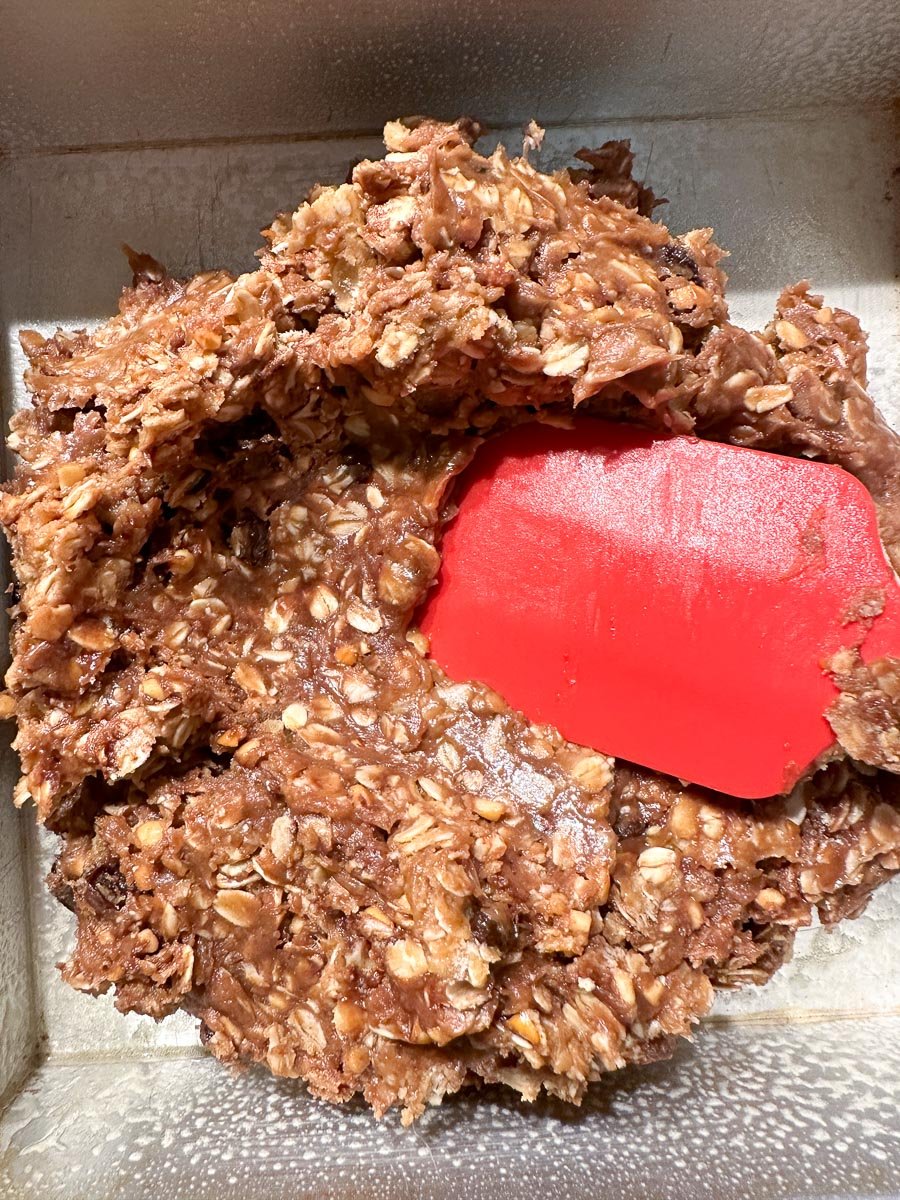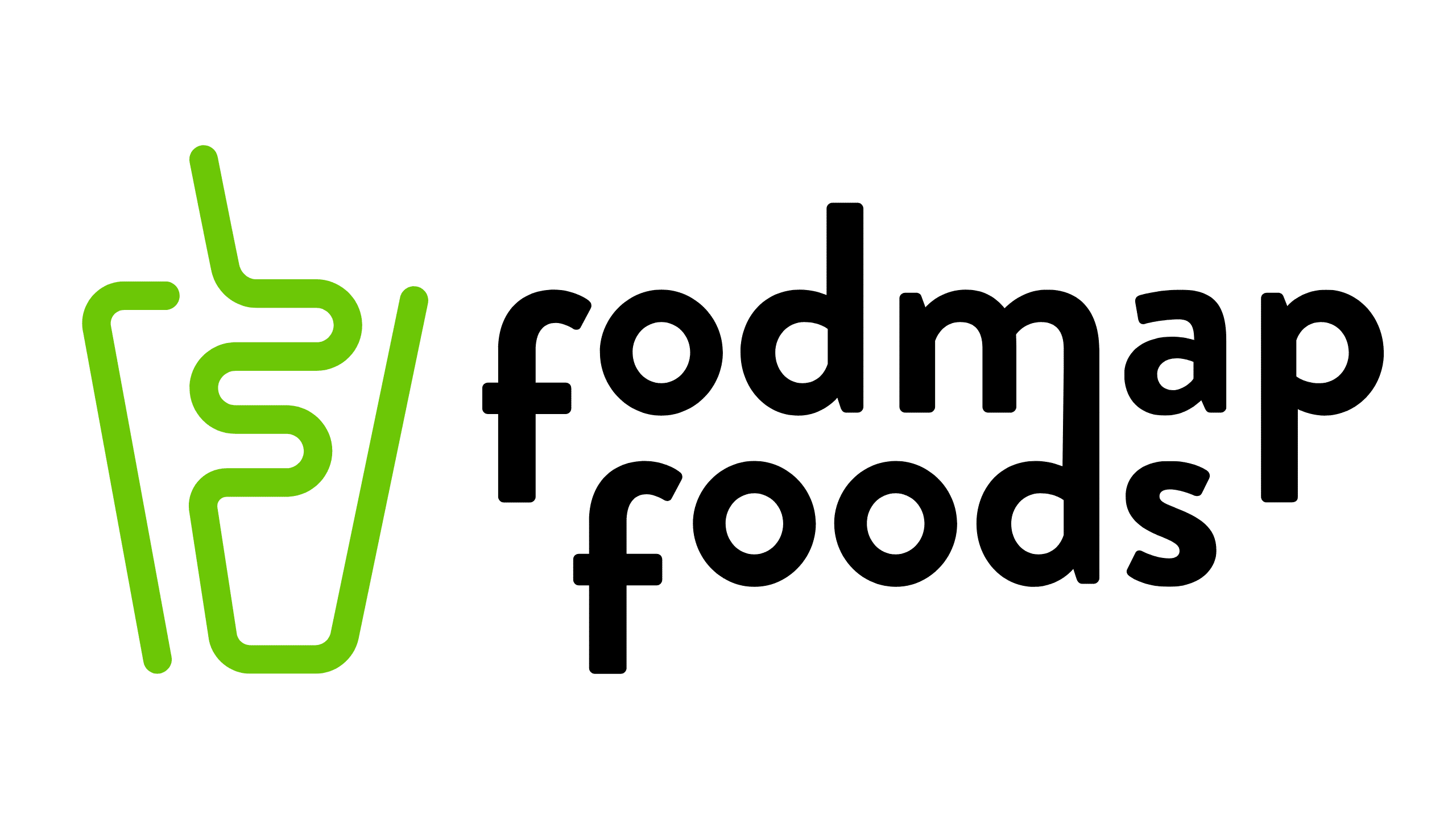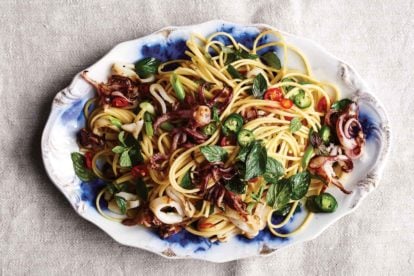If you are looking for a homemade grab-and-go snack option, these Protein & Fiber Low FODMAP Snack Bars fit the bill. They feature FODMAP Foods meal replacement powder, which is Monash University lab tested and certified low FODMAP.
Combined with fiber-rich whole grain oats, these Low FODMAP Snack Bars are super easy to make. The wet ingredients are heated gently, then the wet and dry ingredients are combined, pressed into a pan and chilled. That’s it!

What Is A Low FODMAP Snack Bar?
A low FODMAP snack bar is a portable snack, that’s easy to eat – even on the run – and can be homemade or purchased. We have an article on how to choose the best commercially made low FODMAP snack bars, but this recipe is about making your own.
The two main reasons people reach for snack bars are because they are (hopefully) healthy low FODMAP snacks, and convenient. While making your own certainly takes more effort than purchasing, you get to control the quality of ingredients, and they will be more economical. Keeping in mind that you want quick low FODMAP snacks, we have made sure that this recipe is quick and easy to make.

Meal Replacement Powder & Protein Powder
This DIY low FODMAP snack bars contains a meal replacement powder. If you are wondering what that is, it is in fact not the same as protein powder.
A meal replacement is really good at providing satiety (you feel full) and provides carbs for energy. Dr. Steve Harmon DO of FODMAP Foods, explains them this way:
“A meal replacement is a product that has all three macro nutrients that provide humans with energy: protein, carbs, and fats… Despite all the hate that carbs get, they are actually the currency of energy in humans… Carbohydrates are the preferred energy for the brain as well as for muscle and biological work in the body. By balancing out our product with 40% carb, 30% protein, and 30% fats, we get several benefits. This shake is low calorie, which is good because it can be used to lose or maintain weight. It has carbs in it so that they are available to use for energy.”
Our Favorite Low FODMAP Certified Meal Replacement Powder
There are others on the market, but those made my FODMAP Foods LLC are Monash University certified low FODMAP, and come in a variety of flavors: Vanilla, Chocolate, Raspberry, Lemon, and Orange. I used Vanilla for this recipe.
You could try substituting a low FODMAP protein powder of your choice, but I can only vouch for the results of the recipe is made as presented.

Peanut Butter & FODMAPs
Peanuts are one of those ingredients that might confuse those following the low FODMAP diet, because they have been lab tested multiple times by both Monash University in FODMAP Friendly and the tests of shown different results. Now would be a really good time to review our article on why lab test results can differ.
The important thing to note is that there have been times that peanuts have shown to have no FODMAP content, and also at other times to have mere traces.
Now, when it comes to peanut butter, we have to read labels because not all peanut butter is the same. Here in the United States, there are four basic kinds:
- Freshly Ground Peanut Butter. Often ground to order in the supermarket
- “Natural” Peanut Butter, which will only have three ingredients: peanuts, oil, and salt
- No-Stir Style Peanut Butter Spread, which contains peanuts, palm oil and salt, and while most also contain sugar, Skippy has an unsweetened version. Note that this item is called peanut butter “spread”. This is because palm oil is not one of the FDA’s “optional ingredients” for foods labelled “peanut butter”, hence it is a “peanut butter spread”.
- “Classic” Creamy Peanut Butter: If you are following a recipe from the late 1920s through the 80s, for instance, and it calls for “peanut butter”, the product used was most likely Peter Pan, JIF or Skippy brand and was made from peanuts, sugar, hydrogenated vegetable oil and salt.
All of these peanut butters are low FODMAP, but they do not all act the same in recipes. Therefore, if you just want to spread some on a slice of bread, you can use any kind you like, but if you are making a low FODMAP peanut butter recipe, use the peanut butter that is called for. And, if the recipe does not tell you what kind of peanut butter to use, then that recipe was not developed well, and I wouldn’t trust it anyway.
For this recipe I suggest the no-stir style, and I like using the chunky version, as seen below. If you want to learn more about this versatile low FODMAP ingredient, please read our article, Explore an Ingredient: Peanut Butter.

How To Make Easy Low FODMAP Snack Bars
Coat the inside of an 8-inch (20 cm) square pan with nonstick spray. (If you use a pan with square sides, you will get neater looking bars in the end).
Place peanut butter, almond milk, and maple syrup in a medium size saucepan.

Heat over low-medium heat, whisking occasionally, just until the mixture feels warm, which will only be a few minutes. Whisk the ingredients together so that they are blended well.

Remove from heat and fold in the oats, meal replacement powder, chocolate chips, raisins, and cinnamon.

The warmth of the mixture will melt the chocolate chips, which is what you want. As they firm up, they will help the bars hold together.
Spread the mixture into the pan, using a silicone spatula to create an even surface.

Chill the bars in the pan until firm enough to cut, about 30 minutes. You can also just leave at room temperature for a few hours. The timing is not as important as the firmness in texture. Cut into a 3 by 4 grid to yield 12 bars. Bars are ready to serve. You can store at room temperature in an airtight container for up to 4 days or freeze in an airtight container for up to a month. They defrost quickly.

FODMAP Information
All recipes are based upon Monash University & FODMAP Friendly science at time of initial publication.
- Chocolate: Monash University has lab tested dark, milk and white chocolate all have low FODMAP amounts: 85% dark at 20 g; dark at 30 g; milk at 20 g; white at 25 g. FODMAP Friendly has also lab tested dark chocolate, milk and white chocolate. Their lab tests place low FODMAP servings for dark chocolate at 30 g, with a max low FODMAP serving size of 101 g. Milk chocolate is 30 g with a 38 g max serve; white chocolate is also 30 g with a max low FODMAP serve of 38 g.
- Maple Syrup: Both Monash University and FODMAP Friendly have lab tested maple syrup. Monash says that maple syrup is Green light and low FODMAP in servings of 2 Australian tablespoons (50 g). FODMAP Friendly gives it a “Pass” at 2 tablespoons (53 g). These amounts are recommended due to Australian healthy eating guidelines; no upper limit is posted by either Monash or FODMAP Friendly. Due to its chemical makeup, maple syrup contains more glucose than fructose and therefore can be considered free of FODMAPs. The FODMAP Friendly app does show you that no FODMAPs were detected in lab testing.
- Oats: Both Monash and FODMAP Friendly have lab tested oats. FODMAP Friendly gave rolled oats a “Pass” at ½ cup or 43 g servings; in an update to the app, they report Quick Oats (which are just rolled oats chopped up a bit) as low FODMAP at 47 g, or ½ cup uncooked. Their max low FODMAP serving is 59.53 g. Monash has several app entries and some are country specific. Here we present their “basic” app entries which are not country specific (use your app to look up the other entries). For their main entry called “rolled oats” they say a Green Light low FODMAP serving is ½ cup, which they peg at 52 g. For “quick oats” they state that a low FODMAP serving is only ¼ cup at 23 g, becoming moderate Yellow Light at ½ cup or 47 g.
- Peanut Butter: Monash and FODMAP Friendly have both lab tested peanut butter. We do not have further information as to what kind of peanut butter was tested (unsweetened natural, made with hydrogenated oil and sugar, or no-stir style with palm oil and sugar). Monash shows two entries. We do not know what the images correspond to in terms of type of peanut butter. They state that both are low FODMAP at 2 Australian tablespoons, although one is said to be 50 g and the other 32 g. FODMAP Friendly’s app image shows what looks to be some sort of creamy style (not natural). They give it a “Pass” at 2 tablespoons (50 g), but also state a Max Serve at 6.86 ounces or 192.05 g. It is also important to note that Monash has said peanuts themselves have only trace amounts of FODMAPs and they say that peanut butter only becomes Moderate for fructose at 140 g. If you malabsorb fructose, it might be an issue; for others it might be tolerated very well.
- Raisins: Monash and FODMAP Friendly have both lab tested raisins. While raw grapes contain no FODMAPs, the natural sugars concentrate upon drying and the resulting raisins do contain FODMAPs. Monash says a low FODMAP Green Light serving is 1 Australian tablespoon (13 g). FODMAP Friendly gives them a “Pass” at 3 tablespoons (30 g).
- Spices: Many fresh and dried spice have been lab tested by both Monash University and FODMAP Friendly and are easily looked up in the apps, which we strongly suggest that you have. The additional good news is that if you are interested in a spice that has not been lab tested, you can look at the nutritional panel and assess its FODMAP load for yourself. If the “Sugars” and/or “Carbs” are 1 g or less per serving, then the item would be a good bet to try.
Please always refer to the Monash University & FODMAP Friendly smartphone apps for the most up-to-date lab tested information. Foods will be retested from time to time; in the case of raw ingredients, such as fruits and vegetables, results may vary. All lab tested results are valid and represent a snapshot in time. As always, your tolerance is what counts; please eat accordingly. The ultimate goal of the low FODMAP diet is to eat as broadly as possible, without triggering symptoms, for the healthiest microbiome.
This recipe is sponsored by FODMAP Foods, LTD.

Protein & Fiber Low FODMAP Snack Bars
If you are looking for a grab-and-go snack option, these Protein & Fiber Low FODMAP Snack Bars fit the bill. They feature FODMAP Foods meal replacement powder, which is Monash University lab tested and certified low FODMAP. Combined with fiber-rich whole grain oats, these Low FODMAP Snack Bars are super easy to make. Wet and dry ingredients are combined, pressed into a pan and chilled. That’s it!
Low FODMAP serving Size Info: Makes 12 bars; 1 bar per serving; 12 servings.
Ingredients:
- 1 cup (256 g) no-stir style chunky peanut butter, such as Skippy
- ½ cup (120 ml) unsweetened almond milk
- 1/3 cup (75 ml) maple syrup
- 2 cups (198 g) rolled oats; use gluten-free if following a gluten-free diet
- 1 cup (120 g) FODMAP Foods Vanilla Gut Friendly Protein Meal Replacement Shake powder
- ¼ cup (56 g) miniature semisweet chocolate chips; use vegan if following a vegan diet
- ¼ cup (42 g) raisins
- 1 teaspoon cinnamon
Preparation:
-
Coat the inside of an 8-inch (20 cm) square pan with nonstick spray. (If you use a pan with square sides, you will get neater looking bars in the end).
-
Place peanut butter, almond milk, and maple syrup in a medium size saucepan. Heat over low-medium heat, whisking occasionally, just until the mixture feels warm, which will only be a few minutes. Whisk the ingredients together so that they are blended well.
-
Remove from heat and fold in the oats, meal replacement powder, chocolate chips, raisins, and cinnamon. The warmth of the mixture will melt the chocolate chips, which is what you want. As they firm up, they will help the bars hold together.
-
Spread the mixture into the pan, using a silicone spatula to create an even surface. Chill the bars in the pan until firm enough to cut, about 30 minutes. You can also just leave at room temperature for a few hours. The timing is not as important as the firmness in texture. Cut into a 3 by 4 grid to yield 12 bars. Bars are ready to serve. You can store at room temperature in an airtight container for up to 4 days or freeze in an airtight container for up to a month. They defrost quickly.
Notes:
FODMAP Information
All recipes are based upon Monash University & FODMAP Friendly science at time of initial publication.
• Chocolate: Monash University has lab tested dark, milk and white chocolate all have low FODMAP amounts: 85% dark at 20 g; dark at 30 g; milk at 20 g; white at 25 g. FODMAP Friendly has also lab tested dark chocolate, milk and white chocolate. Their lab tests place low FODMAP servings for dark chocolate at 30 g, with a max low FODMAP serving size of 101 g. Milk chocolate is 30 g with a 38 g max serve; white chocolate is also 30 g with a max low FODMAP serve of 38 g.
• Maple Syrup: Both Monash University and FODMAP Friendly have lab tested maple syrup. Monash says that maple syrup is Green light and low FODMAP in servings of 2 Australian tablespoons (50 g). FODMAP Friendly gives it a “Pass” at 2 tablespoons (53 g). These amounts are recommended due to Australian healthy eating guidelines; no upper limit is posted by either Monash or FODMAP Friendly. Due to its chemical makeup, maple syrup contains more glucose than fructose and therefore can be considered free of FODMAPs. The FODMAP Friendly app does show you that no FODMAPs were detected in lab testing.
• Oats: Both Monash and FODMAP Friendly have lab tested oats. FODMAP Friendly gave rolled oats a “Pass” at ½ cup or 43 g servings; in an update to the app, they report Quick Oats (which are just rolled oats chopped up a bit) as low FODMAP at 47 g, or ½ cup uncooked. Their max low FODMAP serving is 59.53 g. Monash has several app entries and some are country specific. Here we present their “basic” app entries which are not country specific (use your app to look up the other entries). For their main entry called “rolled oats” they say a Green Light low FODMAP serving is ½ cup, which they peg at 52 g. For “quick oats” they state that a low FODMAP serving is only ¼ cup at 23 g, becoming moderate Yellow Light at ½ cup or 47 g.
• Peanut Butter: Monash and FODMAP Friendly have both lab tested peanut butter. We do not have further information as to what kind of peanut butter was tested (unsweetened natural, made with hydrogenated oil and sugar, or no-stir style with palm oil and sugar). Monash shows two entries. We do not know what the images correspond to in terms of type of peanut butter. They state that both are low FODMAP at 2 Australian tablespoons, although one is said to be 50 g and the other 32 g. FODMAP Friendly’s app image shows what looks to be some sort of creamy style (not natural). They give it a “Pass” at 2 tablespoons (50 g), but also state a Max Serve at 6.86 ounces or 192.05 g. It is also important to note that Monash has said peanuts themselves have only trace amounts of FODMAPs and they say that peanut butter only becomes Moderate for fructose at 140 g. If you malabsorb fructose, it might be an issue; for others it might be tolerated very well.
• Raisins: Monash and FODMAP Friendly have both lab tested raisins. While raw grapes contain no FODMAPs, the natural sugars concentrate upon drying and the resulting raisins do contain FODMAPs. Monash says a low FODMAP Green Light serving is 1 Australian tablespoon (13 g). FODMAP Friendly gives them a “Pass” at 3 tablespoons (30 g).
• Spices: Many fresh and dried spice have been lab tested by both Monash University and FODMAP Friendly and are easily looked up in the apps, which we strongly suggest that you have. The additional good news is that if you are interested in a spice that has not been lab tested, you can look at the nutritional panel and assess its FODMAP load for yourself. If the “Sugars” and/or “Carbs” are 1 g or less per serving, then the item would be a good bet to try.
Please always refer to the Monash University & FODMAP Friendly smartphone apps for the most up-to-date lab tested information. Foods will be retested from time to time; in the case of raw ingredients, such as fruits and vegetables, results may vary. All lab tested results are valid and represent a snapshot in time. As always, your tolerance is what counts; please eat accordingly. The ultimate goal of the low FODMAP diet is to eat as broadly as possible, without triggering symptoms, for the healthiest microbiome.
Nutrition
All nutritional information is based on third-party calculations and should be considered estimates. Actual nutritional content will vary with brands used, measuring methods, portion sizes and more. For a more detailed explanation, please read our article Understanding The Nutrition Panel Within Our Recipes.








